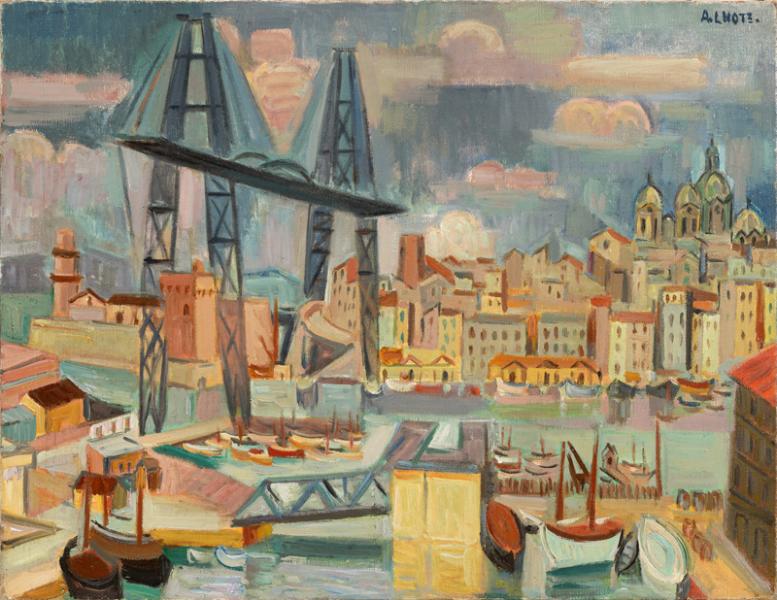Marseille, 1936
Oil on canvas, signed upper right.
50 x 65 cm
Provenance :
Artist's family
Private collection, Paris
Exhibitions :
1968: Montreal, Theo Waddington Galleries
1969-70: San Francisco, Hoover Galleries
1971: London, Victor Waddington Galleries
UNDER THE AEGIS OF THE FERRYBOAT
In 1936, when André Lhote painted this picture, the high structure of the transporter bridge still dominated the port of Marseille. Built to link the two shores of the port, the bridge is made up of two 90-meter-high pylons, connected by a deck that pedestrians can use, and which for a time housed a restaurant. But the main attraction of the ferry is that it can support a gondola in platform mode, shuttling passengers between the Quai du Port and the Quai de Rive-Neuve in just a minute and a half. Since its inauguration in 1905, the bridge has received a mixed reception from locals and painters alike. A bit like Marseille's Eiffel Tower in its reception, the transporter has acquired a symbolic value that crystallizes the debate on modernity. Accused of disfiguring the landscape, in paintings devoted to the port, it is often simply wiped off the map. Gone, as if by magic, are the five hundred tons of scrap metal that encircle the basins with their solid shoulders.
It's certainly not Jean-Baptiste Olive who's going to immortalize it. We often prefer to erase it, to forget its guardianship over the forest of masts in the basins.
Avant-garde photographers, on the other hand, had a field day with this motif, which Moholy-Nagy and Germaine Krull, among others, avidly explored. and contrasts in the 1920s.
Some painters also saw in this airy elegance the emergence of a form of modernity, which happened to be in phase with their work.
This was particularly true of Charles Camoin, Louis Mathieu Verdilhan or Albert Marquet, who often depicted the transporter bridge observed during his stays in Marseille, mainly during the First World War between 1915 and 1918.
Twenty years later, Lhote didn't fail to depict it either, in this bird's-eye view of the harbor from the careening basin. The tapering structure of the bridge rises towards the clouds, while Fort Saint-Jean imposes its square tower between the two iron legs. In this way, Lhote seems to have found a plastic way of depicting the ferry bridge without sacrificing the essential
essential elements of his landscape, reminiscent of Cubism.
The Tour du Roi René and the Tour du Fanal for Fort Saint-Jean, the Church of La Major, the Church of Saint-Laurent... for Lhote, the ferry also seems to be one of the most important monuments of the Old Port.
This work thus divided the painters, on the one hand between the advocates of a contemporary reality, following the same path as photography, and on the other, the often local proponents of a timeless vision of the port, of an unchanging Provence, inherited from the conceptions of the Félibrige, which they found difficult to reconcile with the galloping modernity of the 20th century.
The schism came to an end in August 1944, when the Germans blew up the bridge, never to be rebuilt. For a year, however, part of the bridge remained standing, before it was completely destroyed in September 1945, leaving almost nothing of what was, for almost forty years, the subject of verbal jousting among the people of Marseilles, and even more so in the world artistic community.

